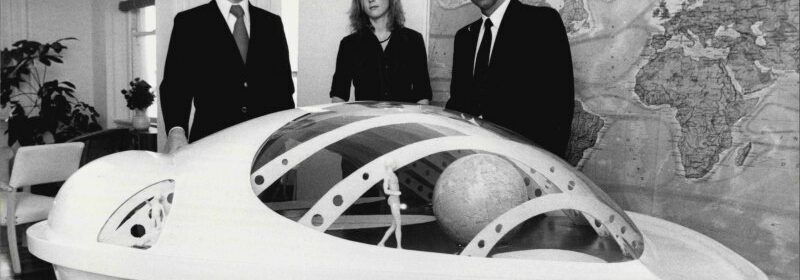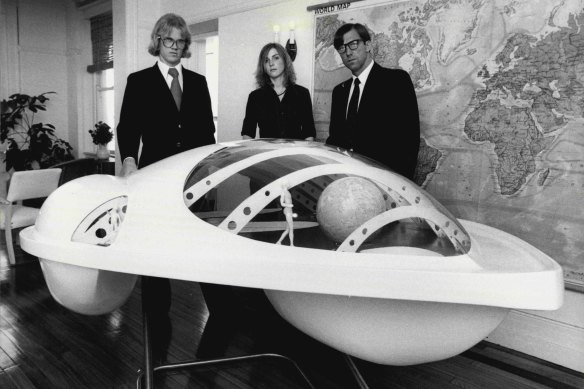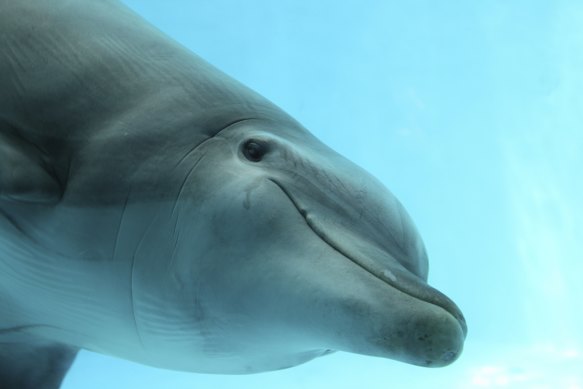From the Archives, 1978: Research goal for Australia’s ‘Dolphin Embassy’

First published in The Age on April 11, 1978
Small talk over dolphins grows
Australia’s “Dolphin Embassy” claims to be well on the way to achieving its ultimate ambition: to crack the language barrier between man and dolphin.
Three members of the Embassy, (l to r) Robert Perry, Alex Morphett and Doug Michels with a model of the research craft.Credit: Robert Pearce
The embassy is a non-profit American research group which moved to Sydney last year to continue its study of dolphins.
It has completed a small, scale model of a $500,000 craft which, it hopes, will tour the oceans for 10 years as a floating research laboratory.
Launching date is two years off. But the aluminium alloy vessel, Oceania —moulded like a starship with gizmos and gadgets and a dolphin pool — is the key to communications discovery, the embassy believes.
The team of, “ambassadors”, headed by America architect Doug Michels and Sydney-born Alex Morphett, say they are funded by US Government grants, philanthropic institutions such as the Rockefeller Foundation, American and Australian businesses and charities.
The group has also gained Australian Film Commission backing for a film called Brainwave, to be written by Tony Morphett who scripted The Last Wave and Certain Women, Mr Michels says.
Dolphin close-up.Credit: iStock
The dolphin devotees left America for Sydney because they believe “Australians, being essentially an ocean people living around the coast, have a natural affinity with the dolphin. And there are more species of cetaceans (the dolphin and whale family) around this shoreline than anywhere else in the world”.
Mr Michels also says he has found evidence of a long-ago association between dolphins and Aborigines … the mammals were an integral part of their totems and dreamtime legends.
He says the Oceania will be the world’s first scientific study of free, wild dolphins. America, Russia and Holland all study captive dolphins in land-based laboratories.
The chief target, the bottle-nosed dolphin, has the brain size most comparable to man’s and is the species commonly mentioned in stories — too numerous to be dismissed — about dolphins saving drowning men or dolphins driving sharks from beaches where humans are swimming.
Mr Michels says: “To establish communication with a sophisticated species such as dolphins — which are of equivalent intelligence to man —demands measures of supreme diplomacy … it is a quantum jump in research.”
He believes that by communicating with dolphins, man may learn about the ocean frontier, marine communities and ecology and even, perhaps, about man’s own pre-history
“The dolphin has been around for 30 million years, compared to our four million.
“There can be 10 generations of dolphins alive at the same time — in human terms, that’s life having Charles Darwin, Leonardo da Vinci and Albert Einstein around all together. The dolphin could give us key information on the evolution of the universe”.
The Oceania project will take ten years — from 1980 to 1990 — with a rotating crew of 12 from all countries in or bordering on the Pacific, Mr Michels says.
The actual language will he divined by a computerised analysis of the high-frequency sounds emitted by dolphins, he says. These noises will be picked up with an ultra-sensitive microphone, then translated through a micro-computer into images on a television screen — circles and dots, for example.
Programmers will collate the symbols and eventually, establish an interpretive language base, he says.
Most Viewed in Environment
From our partners
Source: Read Full Article

